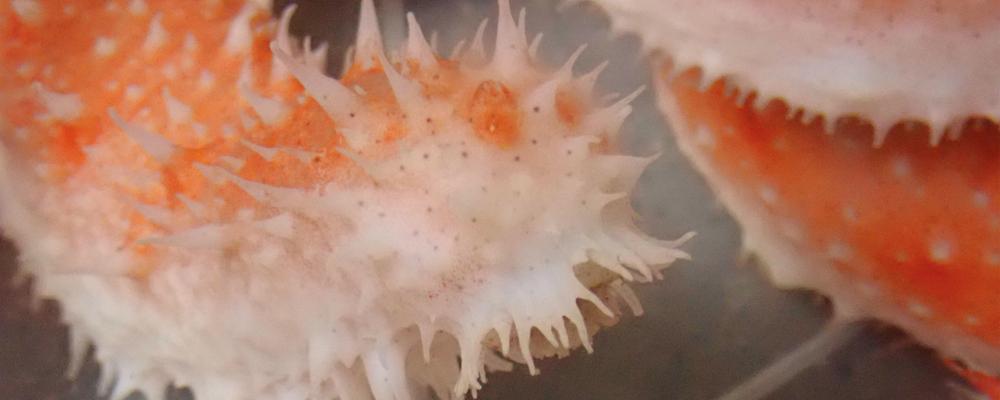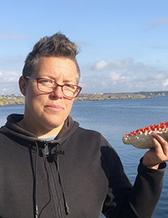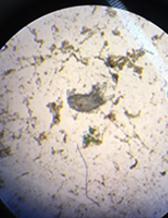
- Home
- News and events
- Find news
- The first sea cucumber bred in captivity
The first sea cucumber bred in captivity
For the first time, the red signal cucumber has been bred in captivity. The aim is to be able to strengthen the population of sea cucumbers in Gullmarsfjorden and to increase knowledge about the role of sea cucumbers in the sustainable cultivation of seafood.
“This is a big first step towards being able to raise large numbers of sea cucumbers to be able to release them into the sea and strengthen populations that for various reasons have decreased,” says Ellen Schagerström, marine biologist, Department of Biological & Environmental Sciences at the University of Gothenburg.

She's a researcher at the Kristineberg Marine Research Station, and last year she managed to get red cucumbers to multiply in captivity for the first time in Sweden. This year, two sea cucumber larvae also passed through all three larval stages and developed into juveniles, i.e. young sea cucumbers.
“Last year, we focused on the first larval stage and examined what they ate and how much they ate. When we cracked that, we were able to optimize that stage this year and that got them to juveniles.”
World-unique success
It's the first time a juvenile red signal cucumber was raised in a laboratory environment. Ellen Schagerström succeeded thanks to the advice of other researchers in the field and by adapting existing knowledge.

“I've used protocols for other species and tried to adapt it because this is a cold water species. Many of the species of sea cucumbers that are grown are tropical or more temperate species.”
Kristineberg Marine Research Station's long history of research also came to use.
“I found a fantastic book in the station's library from the early 20th century by Dr. Theo Mortenssen in Copenhagen, a compilation of echinoderm larvae from the Plankton Expedition der Humboldt-Stiftung 1889. The book has very detailed pictures of what juveniles of a similar species look like. All such puzzle pieces help.”
A way to restore populations
The long-term goal for the research is to be able to breed sea cucumbers and then release them into the sea to replenish the population, for example in Gullmarsfjorden. The sea cucumbers are sensitive to bottom trawling, which previously occurred in Gullmarsfjorden, not least by researchers at the field stations around the fjord.
“It has been documented that a lot of sea cucumber has been caught in trawl lines before, but it has become less and less common, and now it is very rare. Even commercial fishers who often used to get sea cucumbers in crayfish cages rarely see them today. It is worrying,” says Ellen Schagerström.
A large population of sea cucumbers is required for them to reproduce.
“During reproduction, sea cucumbers gather in groups and release their gametes in the sea. But in the water, the cells are diluted. There need to be a lot of sea cucumbers if there is to be any fertilization. We do not know how many, but probably more than there is now in Gullmarsfjorden.”
Even a fertilized egg has a low chance of going through all stages of development and eventually becoming a full-grown sea cucumber.
“They have a natural survival of less than one percent in a laboratory environment. And that is without anyone trying to eat them. If there is one thing that is guaranteed to happen in the sea, it is that someone is going to try to eat you.”
Key in sustainable cultivation of seafood
Sea cucumbers live on the seabed and eat waste from fish, mussels, and pieces of dead algae that sink to the bottom. This also makes them valuable for use in cultivations of fish, algae, or oysters in circular aquaculture.
“If you have sea cucumbers beneath the cultivation of algae and oysters, you'll get more sea cucumbers instead of a lot of waste. It will be better, sustainable and there will be no negative impact on the environment.”
There is a misconception that farmed foods always have a negative impact on the environment, but it doesn't have to be that way, Ellen Schagerström explains.
“It all depends on how you grow food. At the Swedish Mariculture Research Center, we work very hard to find the methods that make cultivated seafood the best to eat in terms of sustainability.”
For those who use sea cucumbers in their cultivation, there is another advantage. Sea cucumbers are considered a delicacy in many parts of Asia, the average price for a kilo of dried red cucumber is around SEK 3,500.
“As a farmer, you get someone to clean for you who you later can sell as a luxury product at a high price. So it doesn't matter that they take a long time to grow.”
How fast the red signal cucumbers grow, when they reach sexual maturity, and how long they live is still unknown. By following the two juveniles, Ellen Schagerström hopes to get an answer.
- We are in unknown territory again. Now that we have juveniles, the next step is to find out how fast they grow and how much waste they can eat.
The breeding of sea cucumbers is part of the SWEMARC project Circular, which is financed by the Swedish Board of Agriculture.